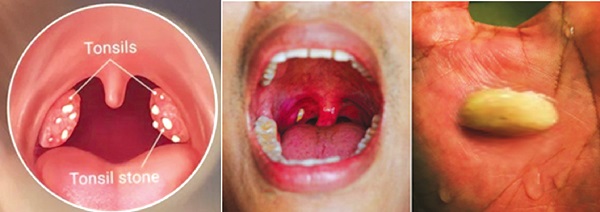
Are tonsil stones harmful?
Tonsils are lumps or gland-like structures of tissue at the back of the throat. Tonsils are part of the lymphatic system which clears away infection and keeps body fluids in balance.
Said differently, the tonsils are part of the body's immune system. Their locations in the throat and on the palate enable them to stop germs from entering the body through the mouth or the nose.
Advertisement
Tonsils also contain a lot of white blood cells which are responsible for killing germs. Tonsils and adenoids work by trapping the germs coming in through the mouth and nose. Adenoids are a mass of enlarged lymphatic tissue between the back of the nose and the throat, often hindering speaking and breathing in young children.
Tonsils, appendix
Even though the tonsils and the appendix (a thin tube that is joined to the large intestine) are located in distant parts of the body, both the appendix and the tonsils are lymphoid organs.
As such, they are integral parts of the body's immune system, albeit of modest importance. Whereas tonsillitis is a painful swelling of the tonsils, appendicitis is a painful swelling of the appendix.
Tonsils and appendix can be removed surgically through tonsillectomy (surgical removal of the tonsils) and appendicectomy (surgical removal of the appendix) respectively.
This means that a person on whom tonsillectomy and appendicectomy were performed can live without the two organs - tonsils and appendix.
There are three types of tonsils namely palatine (on both sides of the throat), pharyngeal (at the back of the throat) and lingual (found at the back or base of the tongue).
Mostly however, people refer to their tonsils as the palatine tonsils, which a person can see at the back of his or her mouth or top of the throat.
Tonsil stones
According to Mayo Clinic, tonsil stones, also called tonsilloliths, are hard, sometimes painful bits of bacteria and debris that get stuck in nooks on the tonsils.
Tonsil stones are common but they rarely cause serious health problems. In fact, many people have tonsil stones but do not even know they have them.
This is because tonsil stones may usually clear up or be removed in the normal course of eating, drinking and good oral hygiene.
They can be treated at home. Tonsil stones look like little white or yellow pebbles on the tonsils. A person may have one or more tonsil stones at a time.
Cause
Tonsil stones are caused or formed by food particles, bacteria and mucus getting trapped in small pockets on the tonsils. These food particles and bacteria can get trapped due to improper oral hygiene or the structure of one's tonsils.
When this trapped material builds up, it can cause swelling and soreness. As such, oral bacteria contribute significantly to tonsil stone formation. Suffice to say by inference that tonsil stone formation can be recurrent.
Symptoms
The occurrence of tonsil stones commonly leads to bad breath because tonsil stones are calcified materials that have offensive odour.
More specifically, symptoms of tonsil stones may include a sensation of something stuck in the throat, irritable cough, bad breath, foul taste, sore throat, difficulty swallowing and ear pain.
Many tonsil stones require no treatment. However, larger ones can be removed by a doctor. However, tonsil stones can also trigger infections and can be difficult to treat with antibiotics.
Precautions
Large and painful tonsil stones that obstruct throat or airway need medical attention. Also, whenever it becomes difficult to remove the tonsil stones at home, one must see a doctor. Trying to scrape them off with a cotton swab or your finger can sometimes make the infection worse.
One should equally see a doctor if any of the following symptoms or a combination of them emerge as they may be a pointer to tonsil cancer.
They include, where one tonsil is larger than the other, bloody saliva, difficulty swallowing or speaking, inability to tolerate eating citrus, neck pain and swelling or lump in the neck.
Aside from the foregoing, good oral hygiene practices such as brushing the teeth in the morning and at bedtime, dental flossing, rinsing the mouth regularly and gargling with warm salt water are necessary to prevent tonsil stones formation.
Treatment
Tonsil stones are usually small. Usually, tonsil stones are not harmful, and they may not need to be treated, but surgical options are available if they become a problem.
Sometimes, tonsil stones get removed during tooth brushing or while clearing the throat forcefully.
Most often than not, treatment of the tonsil stones aims at managing the symptoms outlined above.
There is no specific treatment method for all tonsil stones. Other treatment options are vigorous gargling using salt water and clearing the throat or coughing.
Tonsil stones that come with bacterial or other infections may be treated with prescribed antibiotics.
Conclusion
Tonsil stones are small lumps of hardened material that form in the tonsils which are found at the back of the throat. They are different from tonsillitis, which occurs when the tonsils themselves become infected.
Tonsil stones may not be harmful or cause health problems, but they can cause bad breath or offensive mouth odour. One can usually get rid of tonsil stones using at-home methods such as saltwater gargle and using oral hygiene to prevent their formation. If home tonsil stone removal fails or the stones keep coming back, talk to your provider. If the issue is recurrent infections, you may need a tonsillectomy to remove your tonsils.
The writer is a health service administrator. Email Address: afetikkorto@ yahoo.com



